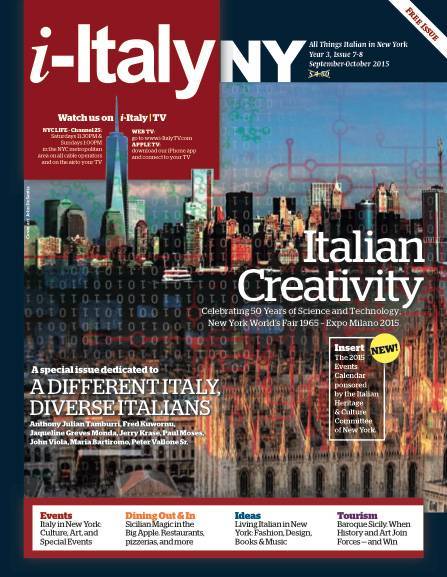What's Hiding Behind the Bend?
— Pascal D’Angelo, Mezzoggiorno
Pascal D’Angelo was a shepherd and poet from Abruzzo. An autodidact, he immigrated to the US in 1910 and was fascinated by the dynamism of his adopted country, despite the occasional hardship he encountered there. His simple yet eloquent verse was published in various American journals, and the fresh air of discovery that permeated his work seems a fitting way to greet autumn in New York.
Although our cover pays tribute to Italian discoveries of another kind—to major Italian contributions to science and technology—an immigrant’s voyage is a similarly courageous excursion into the unknown, one that also requires invention, so we feel justified in introducing this issue of i-ItalyNY with our shepherd poet.
● ● ● ●
This special issue features an insert by the Italian Heritage
& Culture Committee presenting all of the Italian and Italian-American events happening in this city of immigrants during the fall. And because Italy and Italians are so poorly represented by current stereotypes, we have dedicated this issue to differences and diversity by entitling it “A Different Italy, Diverse Italians.”
● ● ● ●
The “Different Italy” described in Maria Teresa Cometto’s cover story is a country that goes beyond fashion, art and good cooking, a country that gave birth to some of the most important scientific and technological innovations of the last fifty years.
The stories of “diverse Italians” that you will find in the following pages speak to a concept of Italianness that transcends ethnic labels and “hyphenated” identities, as reflected upon by Anthony Tamburri. Gennaro Matino talks about the best-known hyphenated Italian, the Italian-Argentine Pope who, in recent weeks, has borne his message of peace and social equality to the Americas. We also introduce you to Afro-Italian director Fred Kuwornu,
a noted champion of dual citizenship in Italy, and Jaqueline Greeves Monda, a sophisticated Jamaican whose marriage to one of New York’s noted Italian intellectuals has led to her “Italianization.” And two multi-hyphenated college professors—a Slavic Sicilian American and a German Jewish Italian American—travel to uncover the Italian side of their respective ancestries, with differing fortunes.
We then profile three very different but equally successful Italian Americans. John Viola, the youngest president in the history of the National Italian American Foundation, talks about the organization’s 40th anniversary and how he intends to transform NIAF into a global ambassador of Italianness in the world. Lucia Pasqualini continues her column on Italian-American mentors and role models, this time discussing how anchorwoman Maria Bartiromo helped her understand her own family’s history. And Peter Vallone, the good old guy of Italian-American politics in New York, talks about his Sicilian origins and how he served as NYC Council Speaker for roughly twenty years.
Finally we attend to some of Italy’s “adopted” citizens—or “Italici,” as Piero Bassetti would define them. They include American architect Dan Meis, who is currently at work on the new soccer stadium in Rome; Italian studies professor Ruth Ben-Ghiat, who talks with Stefano Albertini about her latest book Empire Cinema; and French writer Dominique Fernandez—member of the Académie française, award-winning Pasolini scholar and author of several important essays about Italy— who takes us on a unique tour of Baroque Sicily.
● ● ● ●
Sicily and its particular relationship to difference and diversity is in fact the subject of much of this issue. Previously the region from which Italians emigrated, Sicily now finds itself on the receiving end of immigrants coming into Italy. Here, you’ll also discover a Sicily that is home to art—not just beaches and beachcombers—and get a taste of its cuisine at New York’s best Sicilian restaurants.
● ● ● ●
Through this issue of i-ItalyNY we hope to show you that Italy’s true capital goes by the name “diversity.” Not only is its history a continuous overlapping of cultures, but a steady stream of emigrants has carried that cultural patrimony around the world, opening it up to further transformations. And today’s Italianness is the result of this long, complex process.
So, even if you’re staying in NY this fall, let yourself wander with us—with our magazine and our television show, website and social media—in search of Italianness. Wander like the shepherd poet. What’s hidden behind that bend? You’ll be surprised to find out when you get there.


































i-Italy
Facebook
Google+
This work may not be reproduced, in whole or in part, without prior written permission.
Questo lavoro non può essere riprodotto, in tutto o in parte, senza permesso scritto.